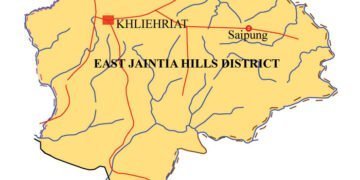With training and hard work of public, the coal mining damaged village of Jarain in East Jaiñtia Hills has managed to revive a nearly dried up spring. The spring locally called Um Thangbru has been the only source of drinking water for them.
The East Jaiñtia District Project Management Unit (DPMU) team under the Community Led Landscape Management project, funded by the World Bank said that in February 2020, prior to the implementation of the knowledge the people got from the training, the discharge of water from the spring was 0.5 liters per minute. One year after the intervention, during February 2021, the reading recorded by the VCF’s was 1.7 liters per minute which is a major increase of 1.2 liters per minute.
Jarain village falls under Saipung C&RD block, 16 km from Khliehriat, the district headquarter. It has a total population of 750 and the number of households is 110. It has a total geographical area of 72.72 ha; however majority of the land around 42.87 ha is left barren or uncultivated. The reason behind this is that this village has been badly affected by coal mining activities where by the landscape has turned highly degraded and most of the water bodies such as springs and streams have either dried up or turned acidic due to coal mine seepage. In addition to facing severe water scarcity, the community people also face a challenge of getting access to clean drinking water and this had an impact on the their livelihoods.
In order to find a solution, the CLLMP conducted a Participatory Rural Appraisal program (PRA) on February 4, 2019 to incorporate the knowledge and opinions of the community in the planning and management of development plans.
During the sessions on Community Natural Resources Management Plan (CNRMP), participants homed on drinking water as their immediate need and proposed the intervention to revive the Um Thangbru spring. They noted that it was the only perennial spring the community people highly depend on. However with time, the discharge of water from this spring has greatly reduced during the lean season and this had raised a concern among the people.
So the community people were trained on various methods of rejuvenation of springs with the help of Assistant Soil & Water Conservation Officer (ASWCO) as a resource person to train the VNRMC and VCF on spring-shed management and soil water conservation techniques.
The DPMU said the training has paid high dividends and will be a model for other areas to follow.





























